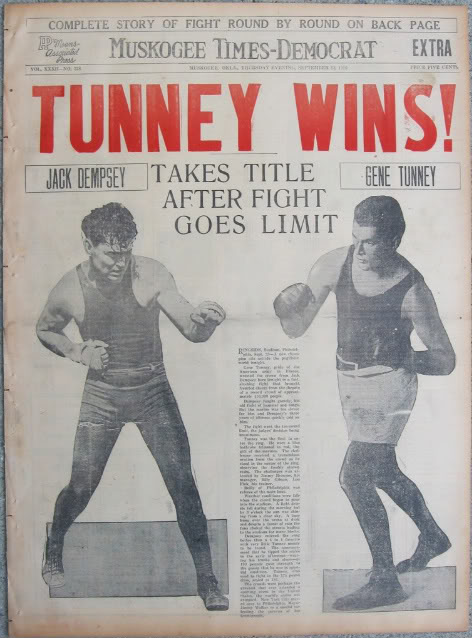Boxing has been part of American culture since the early 1800s. The popularity and notoriety of boxing comes from the legendary characters and fights in its illustrious history. Legendary men such as Floyd “Money” Mayweather, “Sugar” Ray Robinson, Muhammad Ali, “Smoking” Joe Frazier, and Ezzard Charles have produced timeless classics. Bouts such as “the Trilla in Manila” and “Sugar Ray Leonard vs. Roberto Duran II” are a constant reminder of boxing’s grandeur and appeal. However, there was one fight that preceded these and is still as relevant and important as it was when it occurred.1 This bout is known as “The Long Count Fight.” The two characters of this legendary tilt were Jack Dempsey and Gene Tunney.

Dempsey and Tunney were two of the best fighters of the 1920s and each went on to have hall of fame careers. Jack Dempsey was known as the “Manassa Mauler” and was regarded as the people’s champion for his gritty fighting style and charismatic charm. His counterpart, Gene Tunney, was a retired Marine, who was regarded as an intellectual and thus went about boxing with a cerebral and surgical approach.2 These two had met in the ring in September of 1926, and Tunney had been the victor. However, Dempsey was as determined and hungry as ever for another chance to triumph over Tunney. Their rematch the following year would be legendary.
The Long Count Fight was fought on September 22, 1927, and it was fought at Soldier Field in Chicago. Prior to this fight, there had been a new rule implemented that stated that if a combatant was knocked down, the aggressor had to go to a neutral corner before the referee could begin the ten count, which would determine whether the match was over or whether it could resume.3 This rule is what made this fight so controversial.
The first six rounds were going in Tunney’s favor. He was besting Dempsey and the physical toll boxing had taken on Dempsey’s body was beginning to show. It was beginning to look like a repeat of their first encounter. The sixth round was over and the fight was looking like a victory for Tunney; that is, until the fateful seventh round arrived. In the seventh round, Dempsey knocked Tunney down to the mat. However, the referee did not start counting until Dempsey went to a neutral corner, which gave Tunney an extra seven to eight seconds to recover. Dempsey hadn’t been used to the new rule, and as a result, for the rest of that round, Tunney was able to avoided Dempsey. For the rest of the fight, Tunney held his lead on points, even though the crowd showered Tunney with boos for having taken advantage of the long count.4 The crowd also cheered for their man Dempsey until the bitter end. Unfortunately, Tunney was able to avoided Dempsey for the rest of the fight, and eventually won on points. After this fight, one of the greatest heavyweight fighters of all time, Jack Dempsey, retired.
Many believed that the fight had been rigged by way of the referee; others believed that gangsters, such as Al Capone, had influenced the fight.5 In fact, Jack Dempsey once stated “I positively was approached by people in Chicago. I was, in fact, told that for $100,000, I could win the heavyweight championship.”6 Although marred by controversy, neither of those speculations have been definitively proven. But there are many who contend that Dempsey should have been the rightful winner and not Tunney. While the record books will say that Tunney won, it will not be without a metaphorical asterisk. Although Dempsey lost, he was remembered by many as a people’s champion while Tunney was vilified for his role in the match, but still highly respected for his boxing style. Years after this fight, Tunney and Dempsey became close friends and both went on to be boxing Hall of Fame members.7 Both were, are, and forever will be intertwined due to the controversial Long Count Fight.
- Roger Kahn, A Flame of Pure Fire: Jack Dempsey and the Roaring ’20s (New York: Harcourt Brace & Co, 1999), 86. ↵
- Roger Kahn, A Flame of Pure Fire: Jack Dempsey and the Roaring ’20s (New York: Harcourt Brace & Co, 1999), 86. ↵
- Bobby Bearden, “The Time Tunnel: 75th Anniversary of ‘The Long Count,'” Boxing 247, no. 1 (March 2017): 1. ↵
- Roger Kahn, A Flame of Pure Fire: Jack Dempsey and the Roaring ’20s (New York: Harcourt Brace & Co, 1999), 422. ↵
- Bobby Bearden, “The Time Tunnel: 75th Anniversary of ‘The Long Count,'” Boxing 247, no. 1 (March 2017): 1. ↵
- Jack Dempsey, “In This Corner,” Saturday Evening Post 204, no. 9 (August 29, 1931): 25–38. ↵
- Roger Kahn, A Flame of Pure Fire: Jack Dempsey and the Roaring ’20s (New York: Harcourt Brace & Co, 1999), 422. ↵



65 comments
David Alberto
Dempsey, en el combate con Firpo estuvo dos minutos fuera del ring. Si la pelea con Tunney es el de la “cuenta larga”, el encuentro con Firpo seria el de la cuenta “extra-larga”. Todos se han olvidado de ese suceso.
Heather Delligatti
Dempsey is one of the best fighters in our history and he was loved and will never be forgotten
Bianca-Rhae Jacquez
I have never heard of the Dempsey Vs. Tunney before. I love that you were able to explain it in such an easy way. I don’t really like boxing but this boxing match was a game changer. It is surprising that in 2 seconds the whole match can become so controversial. I do think that this match was rigged in my opinion.
Ruben Basaldu
Boxing is a pretty cool sport to watch and I think that I understand the rules of it but I’m pretty sure that I could be wrong but this is a rule that I am not too familiar with. The rule, in my opinion, does not seem fair but I am sure most people feel the same way. I had never heard of this fight or these people but the article does a great job at explaining everything that was going on during this time.
Matthew Swaykus
The only knowledge of boxing I have stems singly and entirely from Sylvester Stallone’s film “Rocky”. I am completely uninformed otherwise, which made this article interesting for me. I’m flabbergasted as to how controversial a couple seconds within each fight can possibly be. Tangling with either of these men would probably hospitalize most people, yet they continued fighting despite receiving continuous, grievous blows. As I said before, I have laughably pathetic knowledge of this sport, but perhaps seeing it from my view – something resembling an ant watching giants clash – will provide a different perspective.
Robert Freise
I am a fan of the sport of boxing and the start of it is very important to me. The professional fight between Tunney and Dempsey was for sure rigged in my eyes. the involvement of the Italian Mafia during this time was huge on a political and crime driven stand point. It is amazing that the fight was sort of a draw and that the fight was involved of a bribery of 100,000 dollars. Great article!!
Christopher Vasquez
Had the new rule not been implemented, Dempsey might have won. It’s a shame that Tunney was able to take advantage of the new rule; however, it does make sense for him to do this since he was a cerebral fighter. I didn’t know that there was so much controversy surrounding the fight. One thing I’m curious about is who the individual was that offered to rig the match in favor of Dempsey before the fight began. This individual had to have a lot of money or power to be able to pull something like this off.
Luke Lopez
This was a very interesting article on the Long Count Fight. I have never heard of this fight before, but I now know that this fight was controversial due to the new rule of the ten second count when a fighter was knocked to the ground. The referee started the ten second count only when Dempsey went to a neutral corner, and not immediately after Tunney fell to the mat.
Didier Cadena
This was a very interesting article. Before reading this article, I had no idea about who both men were or about the fight. I can now see why this fight is still remembered to this day. The new rule ended up working for Tunney’s favor. The way that the article was written helped keep it enjoyable and interesting to read.
Taylor Rech
I enjoy watching boxing occasionally, and this article was very interesting because it shared a little about the history of the sport. As the rematch of two great fighters, the 1927 event a very intriguing one, and the controversy over the implementation of the new rule that could arguably be the reason Tunney won the fight makes it that much more entertaining. Overall, I think this article was good because it peaked my interest and made me wish I could have seen the fight myself so that I could make my own judgement on the fairness of the fight.